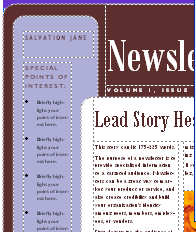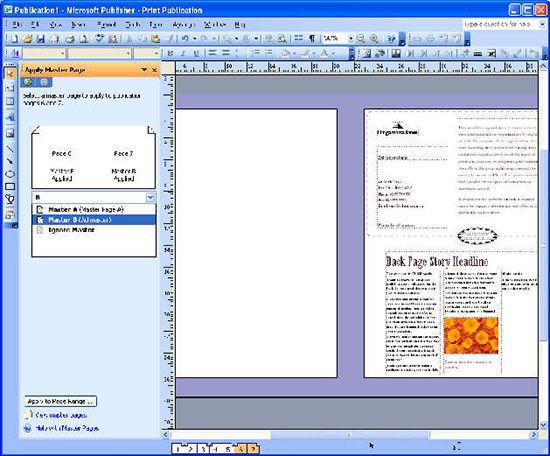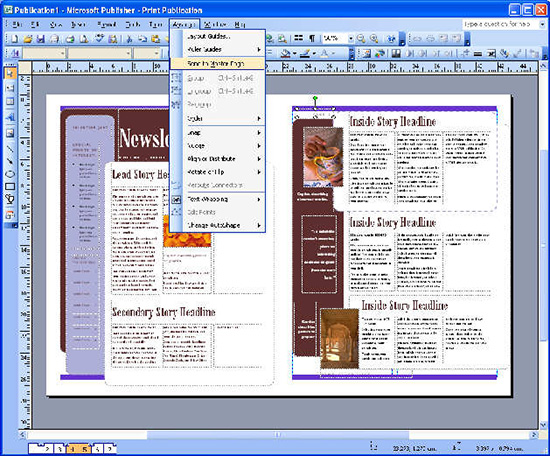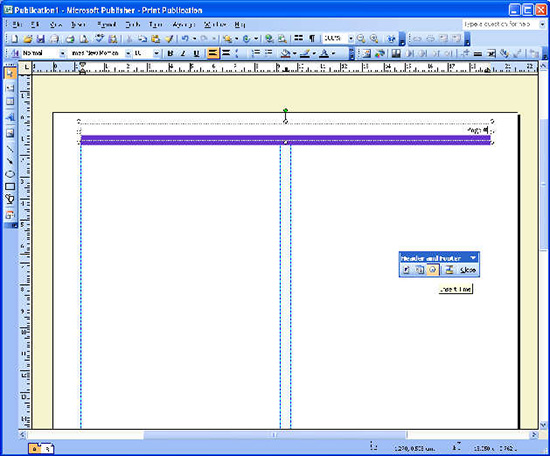|
|
|
Publisher 2003: mastering master pagesHelen Bradley How Master Pages can be used to layout publications to ensure consistency.When creating a publication, having consistent design elements in use across the publication is critical. Your page numbers should appear in the same place on each page and the columns should be the same width and number so that you don't distract your reader's eye. If you're using Publisher, Master Pages are a the tool you'll use to set up elements that appear on every page. Each Publisher publication has at least one Master Page which you use for design objects and guides that appear on all (or nearly all) pages. If you've used Publisher in earlier versions, chances are that you are already familiar with using the background – Master Pages are the replacement for the Background tool. Publisher 2003 lets you have multiple master pages in a publication so you can use different master pages for different areas – for example, you may have a layout for text content in a newsletter and a second one for your pages of advertising. You would create the two masters and then apply one as required to each page depending on its contents. To see the publication’s master page, choose View, Master Page and the Edit Master Pages task pane appears. Here you will see Master A which is the default master page. To change a single page master to a two page master, choose the Change to Two-page option in the dropdown list beside it. A two page master is used when you are planning a two page spread and you want, for example, page numbers to appear on the outside of each page instead of the right side of each page if you were using a single master. To create a new master page, choose New Master Page from the Edit Master Pages task pane and type a new ID which is a single character ID and a description which identifies the page type. Enable the Two-page master checkbox if you need a master for a two page spread. When you are creating a new master page, duplicating an existing master page that is almost what you want is often the quicker alternative to creating one from scratch. Do this by clicking the down arrow beside the master page to copy and choose Duplicate. Now edit the duplicate master to suit your needs. Adding guidesYou can add layout guides to your Master Page to make it easier to line objects up in your publication. To do this, click the down pointing arrow beside the name of the master to alter and choose Layout Guides from the menu. You can then set the guides using the dialog options. If you're working on a master page for a two-page spread you will probably want the two pages to be mirror images of each other with the same elements on the outside edge of master each page and the same elements on the inside edge of each. In fact, you will find that when you're working with a two page master that everything is mirrored on the two pages and a change to something on the outside edge of one page affects the outside edge of the other. If you make changes to a master page you will find the changes are applied to all pages in the publication which use that master page. Because elements on the Master Page appear underneath the elements on the page itself, take care that a change to the Master Page does not have the unexpected result of hiding the moved element on other pages of the publication. Page numbersTo include a page number on a master page, with the master page visible, choose Insert, Page Numbers and then select the position for the number from the dropdown list. If you have more than one master page add page numbers to all of them so that page numbers appear on all pages regardless of the master page used. When you add a page number, Publisher creates a text box for it if you don't create one yourself. If you do create your own text box then the Position list includes an additional option to place the number in the Current text box. You can place other objects in the Master page, for example, your company logo or a graphic with the publication title. In fact, any element that should appear on most, if not all pages should be in the master page. Master Pages - Step by stepPublisher Master Pages are used to manage control the layout of all pages and you can apply a master page to a publication page and move elements from the publication to the Master Page when required. Here's how: Step 1To apply a master page to a publication, in publication view choose Format, Apply Master Page to open the Apply Master page task pane. Locate the page or pages to apply the master page to in the page navigation area and, from the Apply Master Page task pane select the master page to apply.
Step 2To move an object from the publication to the master page, select the object in Publication view and choose Arrange, Send to Master Page. The object will be sent to the master page applied to that page.
Step 3You can set up Headers and Footers on a master page by choosing View, Headers and Footers. The Header and Footer toolbar includes buttons for inserting a page number, date, time and for switching between the header and footer areas. |
|
|
(c) 2019, Helen Bradley, All Rights Reserved. |





